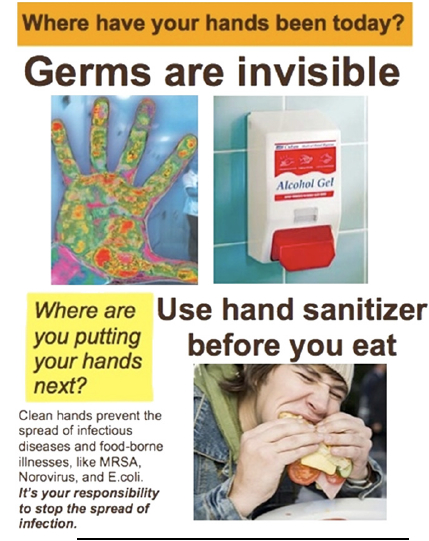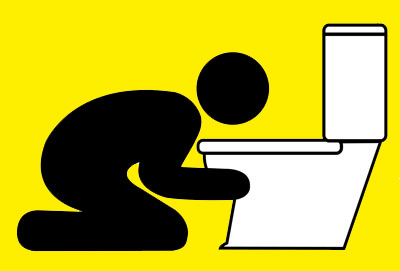Tina Rosenberg of the New York Times writes that in the intensive care units at North Shore University Hospital in Manhasset, N.Y., two L.E.D. displays adorn the wall across from each nurses’ station. They show the hand hygiene rate achieved: last Friday in the surgical I.C.U., the weekly rate was 85 percent and the current shift had a rate of 91 percent. “Great Shift!!” the sign said. At the medical I.C.U. next door, the weekly rate was 81 percent, and the current shift 82 percent.
Those L.E.D. displays are very demanding — health care workers must clean their hands within 10 seconds of entering and exiting a patient’s room, or it doesn’t count. Three years ago, using the same criteria, the medical I.C.U.’s hand hygiene rate was appalling — it averaged 6.5  percent. But a video monitoring system that provides instant feedback on success has raised rates of handwashing or use of alcohol rubs to over 80 percent, and kept them there.
percent. But a video monitoring system that provides instant feedback on success has raised rates of handwashing or use of alcohol rubs to over 80 percent, and kept them there.
Hospitals do impossible things like heart surgery on a fetus, but they are apparently stymied by the task of getting health care workers to wash their hands. Most hospitals report compliance of around 40 percent — and that’s using a far more lax measure than North Shore uses.
How do hospitals even know their rates? Some hospitals track how much soap and alcohol gel gets used — a very rough measure. The current standard of care is to send around the hospital equivalent of secret shoppers — staff members who secretly observe their colleagues and record whether they wash their hands.
This has serious drawbacks: it is expensive and the results are distorted if health care workers figure out they’re being observed. One reason the North Shore staff was so shocked by the 6.5 percent hand-washing rate the video cameras found was that measured by the secret shoppers, the rate was 60 percent.
The North Shore study, published this week in the journal Clinical Infectious Diseases, is the first use of video in promoting hospital handwashing, and the first controlled study in a peer-reviewed journal of a high-tech effort to increase hand hygiene rates.
North Shore instead uses a video monitoring system made by a company called Arrowsight. Cameras on the ceiling are trained on the sinks and hand sanitizer dispensers just inside and outside patient rooms. (Patients are not photographed.) A monitor at each door tracks when someone enters or leaves the room — anyone passing through a door has 10 seconds to wash hands. Arrowsight employees in India monitor random snippets of tape and grade each event as pass or fail.
What makes the system function is not the videotaping alone — it’s the feedback.
The nurse manager gets an e-mail message three hours into the shift with detailed information about hand hygiene rates, and again at the end. The L.E.D. signs are a constant presence in both the surgical and medical I.C.U.s
This is Arrowsight’s first foray into health care. The company’s main business is meat: half the (4).jpg) beef processing plants in America use its video system to monitor workers’ hygienic practices.
beef processing plants in America use its video system to monitor workers’ hygienic practices.
Adam Aronson, Arrowsight’s chief executive, said that at one plant cameras focused on a hand sanitizer dispenser right outside the bathroom. With monitoring and feedback, hand hygiene rates went from about 4 percent to over 95 percent, and the achievement was sustained.
At first Farber feared he wouldn’t be able to get approval; the conventional wisdom was that employees don’t like being videotaped. But then he thought about a recent experience at the dry cleaner: he had picked up some of his daughter’s clothes, but one of her suits was missing. He went back to the shop and told them the date and approximate time of his visit. They pulled up a video that indeed showed him leaving her suit behind. “If dry cleaners are doing that, we need to do that in the hospital,” he thought.

.jpg) similar issue in hospitals. The study was summarized by
similar issue in hospitals. The study was summarized by on the team was Ben Chapman, assistant professor in the department of 4-H youth development and family and consumer sciences at North Carolina State University.
on the team was Ben Chapman, assistant professor in the department of 4-H youth development and family and consumer sciences at North Carolina State University. out for a party, had a good drink and some got food poisoning. Everyone was disgusted.”
out for a party, had a good drink and some got food poisoning. Everyone was disgusted.”.jpg) health care would be 1 in 300," Liam Donaldson, the WHO’s newly appointed envoy for patient safety, told a news briefing.
health care would be 1 in 300," Liam Donaldson, the WHO’s newly appointed envoy for patient safety, told a news briefing..jpg) inserting the catheters. The steps were: Wash hands. Cover the patient with sterile drapes. Clean the skin with chlorhexidine antiseptic. Do not insert catheters into the groin area. Remove catheters as soon as they are no longer needed.
inserting the catheters. The steps were: Wash hands. Cover the patient with sterile drapes. Clean the skin with chlorhexidine antiseptic. Do not insert catheters into the groin area. Remove catheters as soon as they are no longer needed. and the kitchens were not shut down. It is believed that the illness was not food-related, a spokeswoman for NHS Highland said. The food packaging is the suspected source of the illnesses.
and the kitchens were not shut down. It is believed that the illness was not food-related, a spokeswoman for NHS Highland said. The food packaging is the suspected source of the illnesses..jpg) effectiveness of sanitizers.
effectiveness of sanitizers..jpeg) sanitizers and antiseptic products come with claims that they can prevent MRSA (methicillin-resistant Staphylococcus aureus) infections.
sanitizers and antiseptic products come with claims that they can prevent MRSA (methicillin-resistant Staphylococcus aureus) infections..story.jpg)
.jpg) patients in hospitals and other clinics in the U.S. every year.
patients in hospitals and other clinics in the U.S. every year. intentioned in their make-up and purpose, have the potential for unintended consequences, which is why constant surveillance is needed.”
intentioned in their make-up and purpose, have the potential for unintended consequences, which is why constant surveillance is needed.”